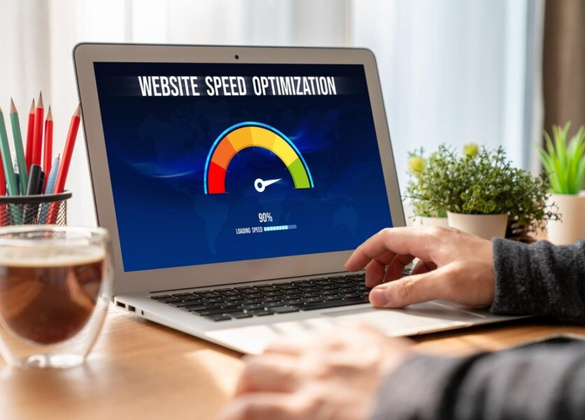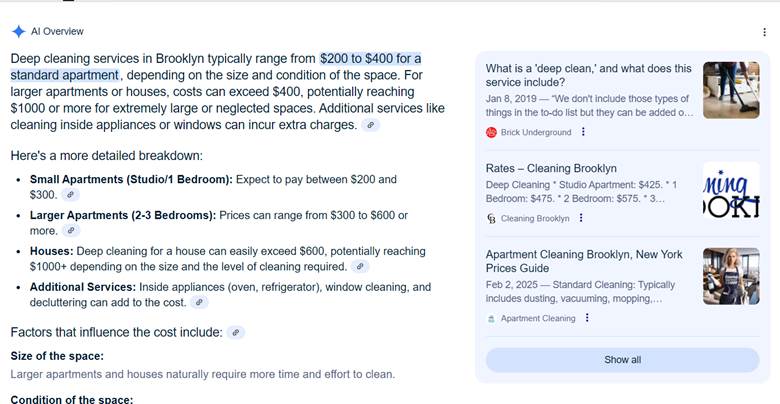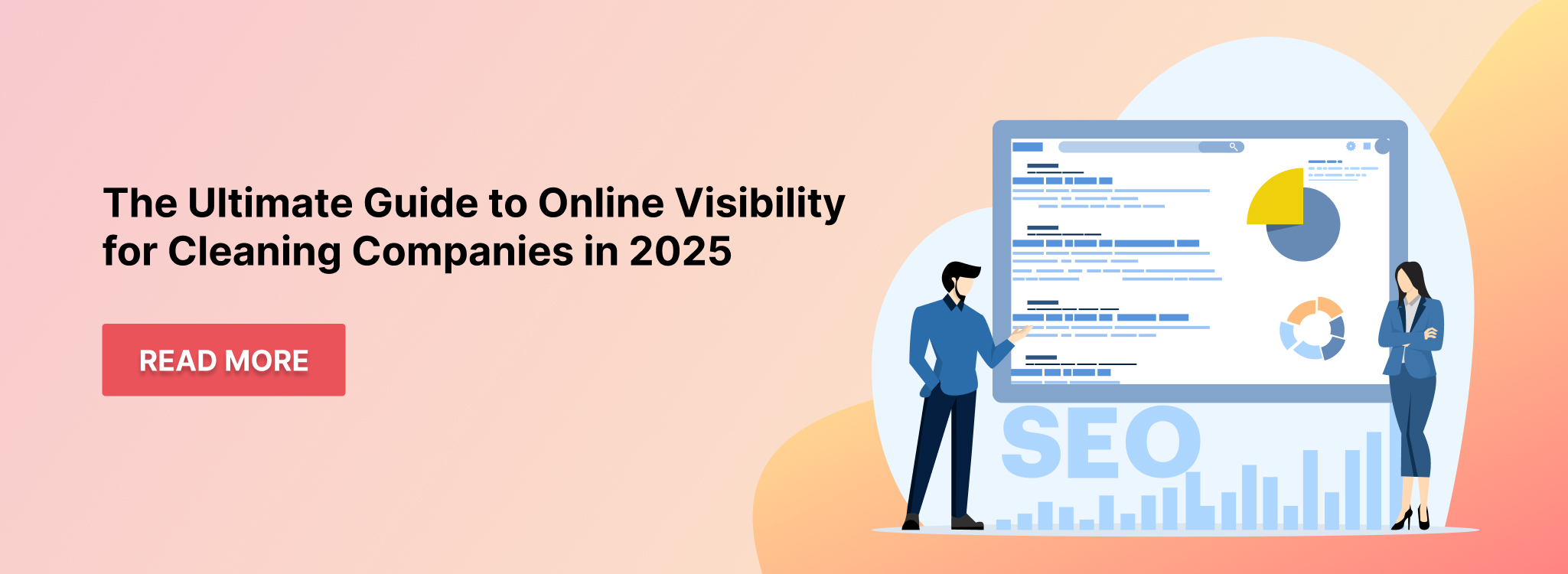Recently updated: August 4th, 2025
This guide includes everything cleaning businesses need to rank higher, get more leads, and stay ahead in the age of AI search
Over 70% of Google searches are going to end up with zero clicks in 2025, according to Briskon’s marketing experts. AI overviews, zero-click results, Google Map packs, and snippet responses are taking over search real estate.
For cleaning companies (and other businesses), this means you could be ranking on Google Page #1 and still getting zero calls, zero inquiries, and zero bookings.
Whether you’re a residential cleaner in New York, a commercial janitorial company covering multiple zip codes, or a specialized cleaning service like post-construction cleanup, your success now depends on showing up across multiple search surfaces, not just traditional organic results. We’re talking about:
- Local 3-pack rankings
- Google’s AI-generated overviews
- Featured snippets and instant answers
- Reviews and brand mentions in trusted directories
- And yes, even AI assistants and voice-based queries
This guide for cleaning company SEO breaks it all down.
Latest Challenges and Issues Cleaning Companies Are Facing Online (in 2025)
If you’re like most cleaning business owners we’ve worked with over the past decade, you’re probably asking: “We’ve got a website, we’re on Google Maps, and we’ve posted a few blogs, so why aren’t we getting more leads?”
The honest answer is the game of SEO for cleaning companies has changed. The SEO practices for cleaning businesses you’re following are outdated. Here’s what’s working against you in 2025:
-
Google’s AI Overviews Are Hijacking Your Clicks
You might technically be “ranking,” but users don’t need to click your link anymore. Google’s Search Generative Experience (SGE) pulls answers from multiple sources and displays them right on the results page.
Unless your content is structured and semantically rich enough to be referenced in these overviews, your visibility is reduced to a silent mention, with zero traffic to show for it.
-
Your Website Looks Fine, But It’s Invisible Locally
A clean layout and decent copy aren’t enough anymore.
If your pages should have geotargeted keywords, proper service area schema, neighborhood-specific content, and optimized meta data.
This will signal Google to show you when someone types in “deep cleaning service near me” or “office cleaning in [city].” That’s when customers are ready to hire.
-
Lack of Brand Mentions on Third-Party Sites is Killing Trust
Google and Large Language Models (LLMs) like ChatGPT and Perplexity don’t just look at your site, they also look at what others say about you.
If your cleaning company isn’t consistently mentioned (with accurate NAP info) on trusted platforms like Yelp, Angi, BBB, Thumbtack, local chamber sites, and niche directories, your authority score stays low, even if your website is optimized.
-
Zero-Click Searches Lead to Zero Leads
“How much does a cleaner cost in NYC?” “What’s included in deep cleaning?” These kinds of searches rarely result in clicks anymore unless your content is explicitly structured to be the answer through AEO strategy, FAQ blocks, markup, etc.
Most cleaning companies? They’re missing these practices entirely.
-
You’re Competing Against Aggregators with Giant Domain Authority
Type in any cleaning-related search, and chances are you’ll see:
👉 Yelp
👉 Angi
👉 Thumbtack
👉 HomeAdvisor
These platforms dominate Page 1 not because they’re better at cleaning, but because they’ve invested in SEO for years.
Unless you actively build local backlinks and signal relevance in your own niche, you’ll keep getting pushed below them in both traditional and AI-driven search.
-
Your Reviews Are Scattered or Nonexistent and That’s a Dealbreaker
Today’s customer checks Google, Yelp, Facebook, BBB, and sometimes even Reddit. If your cleaning business has 3 reviews from 2022 and a competitor has 80 reviews from the last 6 months, guess who gets the call?
You’re not just fighting for attention, you’re fighting algorithms, AI answers, and massive platforms with deep SEO roots.
How to Strengthen E-E-A-T for Your Cleaning Business Website
Google now prioritizes sites that demonstrate Experience, Expertise, Authoritativeness, and Trustworthiness (E-E-A-T), especially for service-based businesses like cleaning companies.
Here’s how to build E-E-A-T into your cleaning company SEO:
Showcase Cleaning Experience Through Real Proofs
- Add before-and-after job photos (tagged by location and date)
- Publish case studies or customer stories, especially for complex jobs (post-construction, medical cleaning, etc.)
- Include employee bios with years of experience or training credentials
Build Authoritativeness as a Leading Cleaning Service
- Get listed in local chamber directories, BBB, and ISSA
- Partner with property managers, HOAs, or local event organizers and get your brand mentioned
- Get featured in blogs, local news articles, or podcasts as a cleaning expert
Create Trust Signals Across Your Cleaning Website
- Display real testimonials with names, locations, and services used
- Use HTTPS and display trust badges (e.g., “Google Guaranteed” if eligible)
- Add a privacy policy, terms page, and a contact page with a business address
When Google and AI tools see these trust signals consistently, they’re more likely to rank and recommend your cleaning business as a reliable local cleaning service.
Local SEO Tactics That Get Cleaning Businesses in the Top 3 Google Map Results
If your cleaning business doesn’t appear in Google’s local 3-pack, you’re not even going to get any leads online.
Here’s what we’ve seen move rankings for cleaning companies up time and time again.
Optimize Your Google Business Profile for Cleaning Services
Your Google Business Profile (GBP) needs to signal to Google (and customers) that you’re an active, trusted, and clearly categorized cleaning service. That means:
- Choose the correct primary category (e.g., “House Cleaning Service” or “Commercial Cleaning Service”)
- Add all relevant services, including niche ones like “Move-In/Move-Out Cleaning” or “Post-Construction Cleanup”
- Upload geo-tagged images of your actual cleaning jobs weekly (not stock photos)
- Use your business description to include location-based keywords naturally
- Answer FAQs, update business hours, and respond to reviews regularly
Most businesses stop after step one. But the cleaning businesses that rank treat GBP like a live platform, not a static listing.
Keep Your Cleaning Company Name, Address, and Phone Number (NAP) Consistent
 One of the biggest ranking killers we see is inconsistency. “123 Main St.” on one listing, “123 Main Street” on another. It seems harmless, but Google sees it as two separate businesses.
One of the biggest ranking killers we see is inconsistency. “123 Main St.” on one listing, “123 Main Street” on another. It seems harmless, but Google sees it as two separate businesses.
So, audit and correct your cleaning business NAP data across:
- Google Business Profile
- Yelp
- Bing Places
- Angi
- Thumbtack
- Local chamber directories
- Data aggregators (Foursquare, Neustar, and Data-axle)
There are tools for this (like BrightLocal or Whitespark), but even manual corrections make a noticeable difference.
How to Optimize for Local 3-Pack Ranking (Proximity, Relevance, and Prominence)
Google’s local algorithm works off three signals:
- Proximity – How close you are to the searcher
- Relevance – How well your business matches the intent (category, keywords, content)
- Prominence – Your authority online (reviews, links, citations, mentions)
You can’t control proximity, but you can absolutely own the other two.
Prominence for cleaning companies often comes down to:
- Quantity and quality of reviews
- Frequency of profile activity
- Volume of trusted citations and backlinks
- Brand mentions on authoritative third-party sites
Target “Near Me” Searches with Service Area Pages
If you serve multiple cities or neighborhoods, don’t just list them in a bullet point on your homepage. Instead, you need to:
- Build out individual service area pages
- Include specific zip codes, local landmarks, and custom content
- Add schema markup to define areaServed
- Embed a Google Map centered on that location
Google needs to see more than “we serve the greater Houston area.” You need page-level local relevance.
How to Do On-Page SEO for Cleaning Company Websites
Once someone lands on your cleaning company site, it has to do two things:
- Tell Google exactly what you do and where
- Convert visitors into inquiries or bookings
Here’s how to build pages that rank well and bring in real leads.
Build Separate Pages for Each Cleaning Service You Offer
 Stop listing everything on a single “Services” page. Google indexes by page, not section.
Stop listing everything on a single “Services” page. Google indexes by page, not section.
If your cleaning company offers:
- Residential Cleaning
- Office Cleaning
- Move-Out Cleaning
- Deep Cleaning
… then each of these services deserves its own optimized individual page.
On every cleaning service page, you need to include:
- Unique intro
- Checklist or service scope
- Price estimates or packages (if possible)
- Local testimonials
- A clear CTA (contact form, booking link, or phone number)
Create Location Landing Pages That Help You Rank Locally
Do you offer cleaning services in multiple cities across the state? Each one gets a page. Period.
What to include in your location landing pages:
- City-specific intro (not just changing the name)
- Relevant services for that area
- Embedded Google Map
- Local photos (if possible)
- Mention of neighborhoods, landmarks, zip codes
- Internal links to service pages
Use Keywords That Match What Ready-to-Book Clients Are Searching
When optimizing your website, don’t target only main keywords such as “cleaning services.” In addition, you will also need to focus on high-intent, localized phrases, such as:
- “Apartment cleaning service Brooklyn NY”
- “Weekly office cleaning downtown Dallas”
- “Move-out cleaning with carpet shampooing”
Use keyword research tools like Google’s Keyword Planner, Ahrefs, or even your own GBP’s insights to find what people are actually typing in when searching for cleaning tips, cleaning services, or cleaning-related questions.
Use Keyword Psychology to Convert More Cleaning Leads
Once someone lands on your cleaning service page, what convinces them to stay, trust, and book? It’s not just keywords. It’s the psychology behind why people hire cleaners in the first place:
- They’re overwhelmed.
- They’re moving.
- They have guests coming.
- They’re worried about dust, allergens, or safety.
Here is how to use keyword psychology and buyer intent to convert more cleaning leads.
Frame Headlines Around Buyer Emotions (Not Just Keywords)
Most cleaning pages focus on generic headers like: “Deep Cleaning Services in Austin” – technically correct, but emotionally flat.
Now imagine this instead:
“Worried About Post-Renovation Dust? Our Deep Cleaning in Austin Has You Covered.”
Same keywords but framed around fear and relief.
Other examples of buyer-intent headlines:
| Intent | Boring Version | Better Version |
|---|---|---|
| Stress relief | Book Residential Cleaning | Tired of Cleaning Every Weekend? Let Us Take Over. |
| Safety/Health | Disinfection Services | Protect Your Family with Our Hospital-Grade Disinfection |
| Convenience | Move-Out Cleaning | Fast, Hassle-Free Move-Out Cleaning in Austin – No Stress, Just Clean. |
CTA Makeovers: Speak to Their Real Motivation
Don’t just tell your potential cleaning service clients what to do. Tell them what they get.
| Weak CTA | Strong CTA |
|---|---|
| Contact Us | Get a Free, Same-Day Cleaning Quote |
| Learn More | See What’s Included in Our Deep Clean (It’s More Than You Think) |
| Book Now | Reserve Your Spot Before the Weekend Rush |
| Call Now | Talk to a Real Cleaner—Not a Call Center |
This small shift improves conversion rates, builds trust, and aligns with what the searcher actually wants – speed, certainty, safety, and a human.
Optimize Title Tags and Headers That Signal Expertise to Google
Your homepage title shouldn’t just say “Welcome to Sparkle Cleaning.” It should say: “House & Office Cleaning Services in Chicago – Sparkle Cleaning”
Use H1 for main keyword, H2s for supporting intent (e.g., “Why Choose Our Deep Cleaning Service in [target location]?”)
Link Internally to Boost Page Authority
To increase page authority, you will need to help Google (and users) navigate:
- Service pages link to relevant blog posts
- Blog posts link to location pages
- Location pages link back to core service pages
Also, keep the content structure clean, logical, and not overly stuffed.
Optimize Images and Alt Text to Support Local Relevance
Every image on your cleaning company website should:
- Be compressed for fast loading
- Have descriptive file names (e.g., “deep-cleaning-bathroom-boston.jpg”)
- Include alt text with context (e.g., “Our team cleaning a client’s office in Cambridge, MA”)
Google’s AI reads these as part of semantic understanding.
Improve Load Speed, Mobile UX, and Core Web Vitals
Your cleaning service site should:
- Load in under 2.5 seconds
- Be fully mobile-responsive
- Pass Google’s Core Web Vitals (Largest Contentful Paint, Cumulative Layout Shift, etc.)
Use tools like PageSpeed Insights and GTmetrix to test and fix what slows you down.
Backlink and Off-Page SEO for Cleaning Companies to Build Authority
Off-page SEO for cleaning services about being recognized online by relevant, local, and high-authority sources. Because when the web talks about you in the right places, Google listens.
Let’s break down how to do off-page SEO for cleaning companies.
Earn Local Backlinks That Help Improve Your Brand Recognition
Getting a link from a cleaning blog in Australia won’t help you rank in Philadelphia. So, what kinds of links help cleaning services rank?
- Local news sites that cover small businesses
- Partnering with property managers, realtors, or interior designers who link to your site
- Sponsorships or event partnerships (e.g., “Proud sponsor of the Downtown Clean-Up Day”)
- Niche industry mentions from janitorial or B2B cleaning suppliers
Example:
A small residential cleaning company in Houston saw a 3-position boost in the Local 3-Pack after getting a single backlink from a local neighborhood association blog post featuring their tips.
How Many Backlinks Do You Really Need for Cleaning Businesses?
 The number of backlinks for cleaning services depend entirely on your local competition.
The number of backlinks for cleaning services depend entirely on your local competition.
- In a small suburb with low competition, 10–15 high-quality backlinks might be enough.
- In dense metros like New York or Chicago, you may need 40–80 referring domains just to match the visibility of well-established companies.
Use top backlink analysis tools to audit your backlink profile like:
- Ahrefs (check your competitors’ backlink profile)
- Semrush or Moz (track referring domains over time)
- Google Search Console (for actual indexed links)
The goal of cleaning service link building isn’t to “get as many links as possible”; it’s to get better links than the businesses ranking above you.
How to Use Anchor Text and Link Placement That Feels Natural (and Signals Relevance)
Anchor text is the clickable text that leads to your site, and what Google sees in that text matters. Example:
❌ Bad anchor: “click here”
✅ Good anchor: “professional apartment cleaning in Austin”
Best backlink anchor text and link practices include:
- Use varied anchor text (exact match, partial match, branded, generic)
- Don’t force keywords because context matters more than precision
- Aim for links within body content, not footers or sidebars
Find Cleaning-Specific Backlink Opportunities
Cleaning specific sites are often overlooked but super valuable. Here’s where to look for:
- Janitorial supply blogs
- Niche local lifestyle sites
- Co-marketing with realtors or interior decorators
- Membership directories from the International Sanitary Supply Association (ISSA)
- Local business networking chapters
- Chamber of commerce pages
Analyze Competitors’ Backlinks and Reverse Engineer What’s Working
This is one of the fastest ways to catch up with companies that are already ranking.
Here’s the simple process to analyze competitors in cleaning domain:
- Plug your top 3 competitors into Ahrefs, Semrush, or Ubersuggest
- Sort by “referring domains” and look for patterns
- Identify:
- Industry blogs or resources linking to them
- Review sites or local listings they’re on
- Guest posts or partnerships
- Pitch similar content or outreach campaigns to those sites
If a competitor is getting link equity from “houstonmomblog.com” in a post about safe cleaning products and they’re ranking because of it. You should be in that post too, or the next one.
Pitch Guest Posts to Sites That Reach Homeowners and Facility Managers
 Generic guest posting isn’t the goal for link building for your cleaning service. You want to write where your potential clients are reading.
Generic guest posting isn’t the goal for link building for your cleaning service. You want to write where your potential clients are reading.
For residential cleaning:
- Local mom blogs
- Community lifestyle websites
- Home improvement and maintenance portals
For commercial cleaning:
- Facility management blogs
- Property management groups
- LinkedIn newsletters related to office culture or business operations
Instead of pitching “an article on cleaning tips,” pitch:
“A facility checklist for post-pandemic office hygiene”
or
“5 things most tenants forget during move-out cleaning”
Make your cleaning guest post pitch as valuable to their readers as your link is to your ranking.
Plan for Brand Mentions on Local News Sites, Chambers, and Vendor Pages
Brand mentions, even without direct links, build trust with AI models and search engines.
How to earn brand mentions for your cleaning business:
- Offer local cleaning tips to community newspapers (they often look for expert contributions)
- List your business with full description and services on your chamber of commerce website
- Ask vendors and partners (e.g., your cleaning supplies distributor) if they have a “featured clients” section
Even a short mention like “This event was sponsored by XYZ Cleaning Services” on a .gov or .edu site can carry massive authority weight.
Prioritize Review Sites That Still Influence Google in 2025
Don’t limit yourself to Google Reviews. Other platforms that Google still crawls and values:
- Yelp
- BBB
- Angi
- Nextdoor
- HomeAdvisor
When building your profile on review sites for your cleaning business, make sure:
- You claim and fully optimize each profile
- Your business info matches your main site (NAP consistency)
- You request reviews on multiple platforms, not just Google
Every active, optimized profile is another branded mention… another trust signal… and another step toward being the most visible cleaning business in your city.
High-Authority Directories & Forums for Cleaning Companies in the USA
Directories and forums may sound outdated, but in reality, they still play a major role in:
- Improving local rankings
- Supporting NAP consistency
- Strengthening branded search presence
- Feeding structured data to Google, Apple, Bing, and AI assistants
- Generating referral traffic from high-intent visitors (yes, people still browse them)
Here’s how to get it right, without wasting time on junk sites or low-quality aggregators.
Being listed in trustworthy local and industry directories adds to your online authority, a key part of E-E-A-T.
Curated List of Directories with Domain Ratings for Cleaning Businesses
Below is a list of trusted, high-authority directories that actively index cleaning companies and contribute to local SEO performance. Each of these is U.S.-focused, crawlable, and used as data sources by other platforms:
| S.No. | Directory | Domain Rating (DR) | Key Benefit |
|---|---|---|---|
| 1 | Google Business Profile | 100 | Direct ranking factor for local 3-pack |
| 2 | Yelp | 94 | High trust and visibility on branded searches |
| 3 | Angi (Angie’s List) | 88 | Used by homeowners looking for verified services |
| 4 | HomeAdvisor | 85 | Leads and reviews from serious home service seekers |
| 5 | Thumbtack | 80 | Lead-gen + strong service categories for cleaning |
| 6 | Nextdoor | 78 | Community trust and neighborhood relevance |
| 7 | BBB (Better Business Bureau) | 91 | Trust indicator with high domain authority |
| 8 | Facebook Business Page | 96 | Engagement + customer reviews = credibility |
| 9 | Bing Places | 84 | Secondary search engine with rich listings |
| 10 | Apple Maps Connect | 82 | iOS visibility for local searchers |
| 11 | Yellowpages.com | 88 | Classic citation source, still trusted |
| 12 | Citysearch / CityGrid Media | 75 | Older citation still used by aggregators |
| 13 | YellowPagesDirectory.com | 74 | Additional brand citation and contact info |
| 14 | Foursquare | 80 | Social check-in power + data syndication |
| 15 | MapQuest | 70 | Map integration and citation source |
| 16 | Porch | 77 | Homeowner-focused, strong cleaning services category |
| 17 | HomeGuide | 73 | Lead-gen and professional listing |
| 18 | Networx | 71 | Lead-gen network with industry-specific pages |
| 19 | GuildQuality | 69 | Review-rich site for service-based trust |
| 20 | TrustedPros | 68 | Niche home services platform for local trust |
| 21 | Cleaning Business Today | 63 | Industry publication with backlinks and mentions |
| 22 | Home Owner Ideas | 66 | DIY and pro visibility for niche topics |
| 23 | Local Home Service Pros | 67 | Small-business focused citation |
| 24 | Click4Home Services | 64 | Home service marketplace with cleaning category |
| 25 | New Home Listing Service | 62 | Niche source tied to move-in service needs |
| 26 | Home Design Directory | 60 | Visibility in design + cleaning cross-niche |
| 27 | eHARDHAT | 59 | Service pro listings and contractor visibility |
| 28 | Popular Home Services | 58 | Directory with aggregated listing power |
| 29 | Top Rated Local® | 70 | Review aggregator with trust signals |
| 30 | Local Chamber of Commerce dirs. | 75 | Boosts local authority and trust |
Pro Tip: Claim your profile and you must fully complete every profile, upload photos, choose categories carefully, and ensure consistent formatting of your NAP across all listings.
Top Niche Cleaning Directories (USA-Based)
Niche cleaning directories are not as widely known, but they send strong topical relevance signals and are often indexed faster because they’re industry-specific:
- com – Regional reviews and business listings
- com – More B2B focused; useful for commercial cleaning SEO
- com (International Sanitary Supply Association) – Ideal for credibility; membership-based
- com – Includes blog features, brand spotlights, and industry partner directories
These won’t drive massive traffic, but they show Google that “This brand belongs in the cleaning industry.”, which is critical for content classification and AI relevance.
Forums and Facebook Groups to Join for Brand Awareness
In 2025, active participation of cleaning businesses in the right forums and groups still delivers value. Here’s where cleaning business owners (and customers) hang out:
Table: Forums & Facebook Groups for Cleaning Business Owners (USA-Based)
| S.No. | Platform / Group Name | Type | Key Benefit |
|---|---|---|---|
| 1 | Clean Freaks – Residential Cleaning Pros | Facebook Group | Peer discussions, job referrals, and vendor tips |
| 2 | Professional House Cleaners Network | Facebook Group | Strategy exchange and community support |
| 3 | Maid Service Success | Facebook Group | Sales, pricing, and growth tactics for cleaning startups |
| 4 | Janitorial Subcontracting Marketplace (USA) | Facebook Group | Find subcontracting gigs and partnership opportunities |
| 5 | The Cleaning Coach – Cleaning Business Support | Facebook Group | Mentorship and operational guidance |
| 6 | Residential Cleaning Business Owners | Facebook Group | Industry-specific challenges, reviews, and templates shared |
| 7 | Pro Cleaners Connect | Facebook Group | Tools, tech stacks, and lead-gen discussions |
| 8 | Women in Cleaning | Facebook Group | Supportive space for women-led cleaning businesses |
| 9 | Commercial Cleaning Owners Only | Facebook Group | B2B sales and commercial bidding conversations |
| 10 | Cleaning Talk Forum | Forum | One of the longest-running cleaning discussion forums |
| 11 | Contractor Talk – Cleaning Threads | Forum | Occasional visibility for cross-niche networking |
| 12 | Reddit r/CleaningBusiness | Transparent advice from cleaners, operators, and marketers | |
| 13 | Cleaning Business Academy Community | Facebook Group | Courses, free resources, and software guidance |
| 14 | Local Cleaning Leads – USA Network | Facebook Group | Lead sharing group by region |
| 15 | Clean It Up Cleaning Business Forum | Forum | Tools, hiring, scaling tips |
| 16 | Pressure Washing Resource Forum – Cleaning Ops | Forum | Overlap niche: useful for exterior cleaners |
| 17 | Cleaning for a Reason Partner Network | Facebook Group | CSR and nonprofit tie-ins for women-owned biz |
| 18 | House Cleaning Talk (CleanGuru) | Forum | Marketing, pricing, and team training discussions |
| 19 | Bidding and Pricing for Janitorial Services | Facebook Group | Pricing breakdowns, RFP examples, and proposal templates |
| 20 | Cleaning Business Marketing Tips | Facebook Group | Organic + paid marketing discussions tailored for cleaners |
Don’t spam and be helpful by sharing advice, answer questions, and subtly showcase your expertise. That builds brand mentions, referral traffic, and sometimes gets your domain shared by others organically.
How to Get Listed and Ensure Consistency for Your Cleaning Brand
 To ensure that you don’t confuse Google’s local algorithm, you need to follow this cleaning citation checklist:
To ensure that you don’t confuse Google’s local algorithm, you need to follow this cleaning citation checklist:
- Use a single, consistent format for your business name, address, and phone
- Make sure to use the same phone number across all listings
- Use your website homepage as the primary URL, unless you have city-specific URLs
- Always choose the closest-matching category (don’t list yourself as “maid” if you do post-construction work)
- Write a short, keyword-rich description that matches the one on your website
- Upload real photos of interiors, your team, your vehicle branding, before/after shots
- Keep track of all logins in a spreadsheet or citation manager tool
- Use a tool like BrightLocal’s Citation Tracker to monitor duplicates and consistency
A single brand mention on a trusted, geo-relevant platform can carry more SEO value than 10 random backlinks.
Technical SEO Fixes That Make Cleaning Websites Easier to Find (and Trust)
Google doesn’t rank broken cleaning websites. If your site loads slowly, confuses Google’s bots, or lacks the right technical signals, it will never perform the way it should.
Here’s what every cleaning business site needs to get right in 2025.
1. Improve Mobile UX
Over 80% of searches that happen on mobile end up in conversions, according to Search Engine Watch. For a cleaning service, it means service booking.
If your cleaning website takes more than 3 seconds to load, requires pinching/zooming to read text or has buttons too close together, you’re losing both users and rankings.
2. Core Web Vital Optimization
Google uses Core Web Vitals to measure how fast and stable your website feels to real users. These metrics directly affect your SEO rankings, especially for mobile users which make up most local cleaning leads.
There are three key Core Web Vitals metrics:
| Core Web Vital Metric | What It Measures | Ideal Target |
|---|---|---|
| LCP (Largest Contentful Paint) | How fast the main content appears | Under 2.5 seconds |
| INP (Interaction to Next Paint) | How quickly your site reacts when someone clicks/taps | Under 200 ms |
| CLS (Cumulative Layout Shift) | How stable your layout is while loading | Less than 0.1 |
Why Core Web Vitals matter for cleaning businesses? If someone clicks your cleaning page from Google and it’s slow, unstable, or unresponsive, they bounce and Google notices.
Tools to Test Core Web Vitals
You can quickly check how your cleaning site performs using:
- Google PageSpeed Insights
- Lighthouse Audit
- GTmetrix
- Chrome DevTools → “Lighthouse” tab
These tools give you real numbers and show exactly what’s slowing your site down.
How to Pass Google’s Core Web Vitals for Your Cleaning Website
Most cleaning company sites are built on WordPress, and many are image-heavy. That’s usually what hurts performance.
Here’s how to fix that:
Optimize Images (LCP)
- Convert large images to WebP format (smaller, faster).
- Use tools like ShortPixel or TinyPNG.
- Resize and compress before uploading.
Use a Lightweight Theme (INP & LCP)
- Switch to fast-loading themes like Astra, GeneratePress, or Kadence.
- Avoid bloated page builders unless well optimized (e.g., Elementor with caching).
Add a CDN and Caching (LCP & INP)
- Use Cloudflare CDN to load faster across the country.
- Install caching plugins like WP Rocket, LiteSpeed Cache, or W3 Total Cache.
Prevent Layout Shifts (CLS)
- Set fixed dimensions for all images and videos.
- Avoid loading fonts or buttons that shift content after load.
Example: A Cleaning Company Case Study
“Before & After Speed Fixes for a cleaning company in NYC”
| Metric | Before Optimization | After Optimization |
|---|---|---|
| LCP | 4.1s | 1.8s |
| INP | 480ms | 130ms |
| CLS | 0.23 | 0.08 |
| Page Load Time | 5.2s | 1.9s |
What we did:
- Switched to Astra theme
- Compressed all homepage images to WebP
- Installed Cloudflare + WP Rocket
- Disabled unused plugins and scripts
Within 2 weeks, rankings improved for “move-out cleaning NYC” and bounce rate dropped by 28%.
📋 Checklist: Core Web Vitals for Cleaning Websites
| Task | Done? |
|---|---|
| Images compressed and converted to WebP | ☐ |
| Theme optimized for speed | ☐ |
| CDN and caching enabled | ☐ |
| Fonts and layout shifts fixed | ☐ |
| Mobile speed under 2.5s | ☐ |
-
Speed Up Your Website and Make It Secure with SSL
 Speed and security are no longer optional for cleaning business or any business. They’re expected by Google and your customers.
Speed and security are no longer optional for cleaning business or any business. They’re expected by Google and your customers.
Your cleaning service site should:
- Use HTTPS (no padlock means no trust and no rankings)
- Have image compression set up (use WebP format when possible)
- Use browser caching and a content delivery network (CDN) for faster global loads
- Avoid bloated themes and unnecessary WordPress plugins
Remember, even a one-second delay in load time can cause a 7% drop in conversions. For a cleaning company, that might mean dozens of missed leads every month.
-
Fix Crawlability Issues So Google Can Index Your Pages
If Googlebot can’t access or read your cleaning service pages properly, they don’t exist as far as rankings go.
Here are the common issues we see on cleaning business sites:
- Noindex tags accidentally added to service pages
- Broken internal links that lead to dead ends
- Incorrect robots.txt files blocking entire directories
- Missing or outdated XML sitemaps
Here is how you can fix crawlability issues on your cleaning website:
- Make sure your most important cleaning service pages (services, locations, reviews) are crawlable and indexable
- Run a site audit with Screaming Frog, Sitebulb, or Semrush
- Submit your updated XML sitemap to Google Search Console
-
Add Structured Data That Tells Google You’re a Local Cleaning Business
Structured data (also known as schema markup) helps search engines understand exactly who you are, what you offer, and where you serve.
For cleaning companies, these types of schema matter most:
- LocalBusiness – Defines you as a local service provider
- Service – Highlights what you do (deep cleaning, move-out cleaning, etc.)
- Review – Tells Google what real customers are saying
- FAQPage – Boosts AEO and rich snippets
- AreaServed – Lets AI understand your target cities and zip codes
You need to add schema to:
- Homepage
- Each service page
- Each city/location page
- Blog posts with FAQs or how-to content
Use tools like Schema Markup Generator or plugins like RankMath or Yoast SEO to apply and test your markup.
-
Set Up XML Sitemaps and Robots.txt the Right Way
Sitemaps tell Google what pages you want indexed. Robots.txt tells Google and AI bots what to avoid.
Here is your checklist for sitemaps:
- Ensure your sitemap includes all key pages, not just blog posts
- Include service pages, location pages, and any key FAQs
- Submit the sitemap in Google Search Console
- Check your robots.txt file isn’t blocking key content (/services/, /locations/, etc.)
A clean sitemap often leads to faster indexing, and a clear robots.txt means no accidental exclusions.
-
Make Your Site AI-Ready to Appear in Google’s AI Overviews
In 2025, Google’s AI Overviews and snippets are pulling structured, semantically rich data from multiple sites to build instant answers. Your site needs to be one of those trusted sources.
To optimize your website for Google AI Overviews and snippets, you need to:
- Add clear FAQ sections to every service and city page
- Use short, concise answers with proper headings
- Use schema to label these sections as FAQs or Q&A
- Write descriptive subheadings (e.g., “How much does move-out cleaning cost in Boston?”)
The more clean, answerable data you feed Google, the more likely you’ll be referenced even if you don’t win the #1 blue link.
Get this part right, and every content, backlink, and citation strategy you run will perform 10X better.
How to Create Content That Ranks in Google and Gets Picked Up by AI Overviews
The way people search has changed. Now, we’re dealing with:
- AI Overviews that summarize entire queries without needing a click
- Zero-click results where answers are pulled from multiple sources
- LLMs (language learning models) that understand context, semantics, and topical authority
To win visibility in this new environment, your content must do two things:
- Help people instantly
- Give machines clear, structured signals
Here’s how to rank your content in Google and get it picked by AI Overviews.
Build a Content Cluster Strategy for Cleaning SEO
A content cluster is a group of interlinked pages that cover a single topic deeply, starting with one core page (e.g., “Deep Cleaning Services”) and several supporting blog posts or FAQs (e.g., “How long does deep cleaning take in Boston?”).
This strategy helps Google (and AI models) understand that your site is an authority on cleaning services. And the more helpful, connected content you publish, the more likely you’ll be cited in:
- Featured snippets
- AI Overviews
- Voice search answers
- “People Also Ask” boxes
Example: How to Build a Cleaning SEO Content Cluster Structure
Let’s say your cleaning company offers deep cleaning services in Boston. Here’s how you’d structure the cluster:
Core Page:
- /deep-cleaning-services-boston
Supporting Blog Posts:
- how-long-does-deep-cleaning-take-boston-apartments
- top-mistakes-before-move-out-cleaning
- what’s-included-in-deep-cleaning-vs-regular
- deep-cleaning-checklist-for-boston-renters
- how-to-prepare-for-deep-cleaning-day
Internal Linking Strategy:
- Every blog post links back to the core deep cleaning page
- The deep cleaning page links out to relevant blog posts as FAQs or “Further Reading”
- All blog posts also link to the Boston city page, if it exists
Example:
In the blog “How long does deep cleaning take in Boston apartments?”, add: “For a detailed list of what’s included, check our Deep Cleaning Services in Boston page.”
Content Cluster Map (Text-Based Representation)

Each blog post supports the core page. Together, they form a semantic neighborhood, which will help you rank not just for the core keyword but dozens of related searches.
To ensure your content cluster is connected properly, use tools like:
- Screaming Frog (desktop crawler that maps all links)
- Ahrefs Site Audit → Internal linking → Orphaned pages
- Surfer SEO or Frase → to see missing keyword topics
- Google Search Console → Links → Internal links section
What to Check When Linking Content Cluster:
- No “orphan pages” (blog posts with zero internal links)
- Each blog links to the core service page
- Blogs use natural anchor text like:
- “deep cleaning checklist”
- “move-out cleaning tips”
- “Boston cleaning packages”
📋 Content Cluster Checklist for Cleaning Companies
| Task | Done? |
|---|---|
| Created a core page for each major service (deep cleaning, office cleaning, move-out) | ☐ |
| Published 3–5 supporting blogs around each core topic | ☐ |
| Linked all blogs to the core service page | ☐ |
| Added contextual links to/from city pages | ☐ |
| Audited links monthly using Screaming Frog or GSC | ☐ |
Write Content That Makes Sense to Humans and Language Models (LLMs)
 In the past, you wrote “for Google”. Now, you need to write cleaning company website copy and blog posts for:
In the past, you wrote “for Google”. Now, you need to write cleaning company website copy and blog posts for:
- People who scan fast
- Google’s AI summaries
- LLMs like ChatGPT, Claude, and Perplexity AI that generate answers using your page as a reference
The best way to do it is: clear, scannable, structured writing.
Best content marketing practices for cleaning companies include:
- Keep sentences short (12–18 words max)
- Use headings like a table of contents and each one should clearly describe what comes next
- Break big paragraphs into 2 to 4 line blocks
- Use simple, concrete language, especially when explaining your cleaning services
For example:
Instead of:
“Our comprehensive offerings provide unparalleled sanitation coverage across multiple segments.”
Say:
“We offer home cleaning, office cleaning, and move-out cleaning – each with its own checklist and flat-rate pricing.”
Simple and clear writing wins because both people and AI can understand and reuse it.
Add Glossaries, FAQs, and Semantic Keywords to Cover the Topic Fully
AI models favor pages that answer everything in one place. For example, if you have a page about “Deep Cleaning Services,” it shouldn’t just list features. It should also include:
- What’s included in deep cleaning
- How much it costs
- How long it takes
- Why it’s different from regular cleaning
- FAQs like “Is deep cleaning worth it?” or “How often should I schedule deep cleaning?”
This is called semantic coverage, and it tells Google, “Hey, this page is the definitive resource on this topic.”
Plus, you also need to add:
- Glossary of cleaning terms (great for AI training data)
- Related questions at the bottom of each page
- Service-specific FAQs (e.g., deep cleaning vs. move-in/out cleaning)
Optimize Your Pages to Answer Questions Google and AI Models Look For
The process of optimizing your cleaning service pages in a way that it can answer questions that Google and AI models look for is called Answer Engine Optimization (AEO) and it’s one of the biggest strategies for showing up in:
- Featured snippets
- Google’s SGE responses
- Voice search via Google Assistant or Alexa
- AI bots that cite your website in their answers
How to implement AEO in your cleaning company website:
- Start each FAQ answer with a direct, 1–2 sentence summary
- Then, follow up with more explanation or steps
- Use question-style headers:
- ❌ Don’t write: “Cleaning Pricing”
- ✅ Write: “How Much Does Deep Cleaning Cost in Dallas?”
- Add schema markup: FAQPage, HowTo, QAPage
When your content directly answers questions in plain English, Google doesn’t just rank it but also uses it.
Format Content for Featured Snippets and Google’s SGE Summaries
 Google’s AI looks for patterns. If you want to get featured in snippets or SGE:
Google’s AI looks for patterns. If you want to get featured in snippets or SGE:
- Use bulleted lists (great for “how-to” snippets)
- Add numbered steps (great for “process” queries)
- Use comparison tables (for cleaning types, pricing tiers, etc.)
- Highlight definitions in bold or italics
- Keep intros under 40 words when answering questions
Example:
What is move-out cleaning?
Move-out cleaning is a deep cleaning service performed when tenants vacate a home or apartment. It usually includes appliances, baseboards, bathrooms, and often carpet shampooing.
Optimize Your Cleaning Website for Voice Search and AI Assistants
In 2025, voice assistants like Google Assistant, Siri, and Alexa are answering more local service questions than ever. If someone says, “Who offers weekly apartment cleaning near me?” your site needs to sound like the answer.
Here’s how to optimize your content for voice search:
- Write answers in a conversational tone, just like how people speak.
- Use full questions as subheadings (e.g., “How long does a deep clean take?”)
- Keep answers short and direct and aim for 40–60 words upfront.
- Add local context naturally, like: “In Scottsdale, most move-out cleanings take 4–6 hours.”
- Include long-tail keywords with conversational triggers like:
- “best cleaning service near me”
- “who offers move-in cleaning in [city]?”
- “how much does it cost to deep clean a condo?”
Voice-friendly pages are more likely to show up in SGE, featured snippets, and smart assistants, especially when supported with structured data.
The clear answer structure and format is best for AI snippets and voice-based queries.
How to Optimize Your Cleaning Business for Hyperlocal and “Near Me” Searches
In 2025, Google is prioritizing hyperlocal content as it wants to know which streets, neighborhoods, suburbs, or zip codes you’re really active in.
This section will show you how to win visibility in micro-markets like neighborhoods, suburbs, and even apartment complexes.
Structure Location Pages to Capture “Near Me” and Neighborhood Keywords
When someone searches:
- “maid service near me”
- “office cleaning in East Austin”
- “deep cleaning 77057 zip”
Google wants to serve locally optimized pages, not generic service pages.
Here’s how to structure location pages the right way:
- Create individual pages for each key area (city, suburb, or zip cluster)
- Mention specific neighborhoods and streets you serve (e.g., “We regularly clean townhomes in South Lamar and condos near Barton Springs”)
- Include localized content like testimonials from clients in that area
- Use page titles like: “Move-Out Cleaning Services in Scottsdale AZ – Fast & Reliable”
- Add service modifiers: “Weekly apartment cleaning in Downtown Houston” or “Post-renovation cleanup in Tempe 85281”
Tip: Use Google Search Console to identify location-based keywords that are already bringing you traffic and double down on them with dedicated pages.
Use Geo-Tagged Images and Area-Specific Schema to Boost Local Signals
 Every time you upload a photo to your site, it’s an opportunity to show Google where you operate. Geo-tagging (adding location metadata to images) helps support local visibility, especially in Google Images and Google Maps results.
Every time you upload a photo to your site, it’s an opportunity to show Google where you operate. Geo-tagging (adding location metadata to images) helps support local visibility, especially in Google Images and Google Maps results.
How to geo tag your images in Google Images:
- Take real job site photos
- Use tools like GeoImgr to add coordinates before uploading
- Name files descriptively, such as move-out-cleaning-scottsdale-kitchen.jpg
- Use alt text like: “Our cleaning crew finishing a deep clean in Scottsdale, AZ apartment kitchen”
- Also, add LocalBusiness and AreaServed schema to each service area page with: Service area zip codes, City names, and County or metro references
This helps LLMs and Google SGE better associate your brand with those locations.
Embed Google Maps and Real Job Photos to Reinforce Local Relevance
Adding real job photos and embedding Google Maps may seem small, but it’s incredibly powerful. For each city or neighborhood page, you need to:
- Embed a Google Map with a pin in the service area (not just your HQ)
- Add before-and-after photos of actual cleaning jobs from that area
- Mention real landmarks or cross-streets (e.g., “near Hyde Park Market” or “adjacent to the University District”)
These cues tell search engines that “This business is not just saying it serves the area—they’ve actually worked here.”
Create Zip Code and Region Pages with Unique, Differentiated Content
A huge mistake we see is businesses creating copy-pasted location pages that just change the city name. Google sees through that instantly.
Instead:
- Group service areas by zip code clusters (e.g., “77057, 77056, and 77024 – West Houston”)
- Write unique introductions tailored to that region’s demographics or needs
- Talk about common cleaning issues in that area (e.g., hard water, construction dust, student housing move-outs, etc.)
- Mention relevant partners or clients in that region (when appropriate)
Bonus: Create ZIP-targeted blog posts, such as “Best Times to Schedule Deep Cleaning in Scottsdale 85257” or “How to Prepare for Move-Out Cleaning in Brooklyn 11211”.
These types of pages often rank in both organic results and AI-generated local overviews.
How to Do Video SEO for Cleaning Companies
In 2025, video is one of the most underused SEO tools, especially for local service businesses. Why? It’s because YouTube videos now show up in:
- Google AI Overviews
- Featured snippets
- Google Maps listings
- Mobile-first SERPs
- Voice search answers
And here’s the best part: Even a 45-second clip shot on your phone can help you rank higher, earn more clicks, and build trust, when optimized correctly.
What Type of Videos Should Cleaning Businesses Post?
 You don’t need to create polished commercials. Instead, keep it real and useful. Here are cleaning video ideas that work:
You don’t need to create polished commercials. Instead, keep it real and useful. Here are cleaning video ideas that work:
- How We Do It
“How we do move-in cleaning in NYC apartments”
Walkthrough of your actual cleaning job with optional voice-over. - Before & After Series
Show transformations (especially post-renovation or move-out). - Tips & Mistakes
“3 mistakes people make before move-out cleaning” - Cleaning FAQs in Video Format
“What’s included in a deep cleaning package?” - Behind-the-Scenes (Optional)
Team prep, tools used, or eco-friendly products (trust builder). - Neighborhood Spotlights
“Move-out cleaning near Brooklyn’s Williamsburg apartments” - YouTube Shorts
Quick, punchy tips under 60 seconds. Title idea:
“1 Cleaning Tip for Pet Hair in Apartments”
How to Geo-Tag Videos for Local SEO
Geo-tagging tells YouTube (and Google) where the video is relevant. Here’s how to geo-tag your cleaning videos:
- Before Uploading (Optional):
Use tools like GeoSetter or Pic2Map for photos/screenshots. - After Uploading to YouTube:
- Go to YouTube Studio → Content
- Click on your video → More options → Add location
- Enter the neighborhood, city, or zip code
This helps your video appear in local search results (both Google & YouTube).
Optimize Your Cleaning Videos for SEO (Step-by-Step)
Use the same SEO best practices you apply to web pages.
- Keyword-Optimized Title
- Good: “Move-Out Cleaning in Downtown Miami – Real Job Footage”
- Not Good: “Cleaning Video Ep. 3”
- Description (at least 250 words)
- Include your company name, service, location, and a CTA
- Example: “Looking for move-out cleaning in Miami? [Your Brand] shows how we handle full apartment turnover jobs. Book a cleaning: www.yoursite.com”
- Tags
- Add: “move-out cleaning Miami”, “apartment cleaning tips”, “cleaning service near me”
- Transcript & Captions
- Auto-captions are OK, but editing or uploading a transcript helps AI interpret your video better.
- Thumbnail
- Upload a clear before/after or action shot (avoid blurry images)
Embed & Link YouTube Videos Strategically on Your Website and GBP
Once your video is uploaded:
- Embed it on the related service page
(e.g., /move-out-cleaning-boston) - Embed it on your city landing pages (e.g., /cleaning-services-nyc)
- Add a YouTube link in your Google Business Profile
- Share in local Facebook groups, forums, and community pages
This creates a multi-channel presence, which boosts your authority, trust, and visibility.
📋 YouTube Video SEO Checklist for Cleaning Companies
| Task | Done? |
|---|---|
| Create 1–2 short videos per core service | ☐ |
| Add service + city keywords in title | ☐ |
| Add 250+ word description with CTA | ☐ |
| Tag video with keywords and location | ☐ |
| Upload transcript or captions | ☐ |
| Embed on website (service/city pages) | ☐ |
| Add YouTube link in GBP & social profiles | ☐ |
How to Use Reviews and Trust Signals to Win More Cleaning Clients
Reviews aren’t only for customers but also used for ranking factors, authority indicators, and conversion drivers.
Here’s how to turn reviews of your cleaning company into assets that work 24/7.
Aim for 4.8+ Ratings and Use Real Customer Photos to Build Instant Trust
Consistent 4.7–4.9 ratings with recent reviews and real customer photos can help gain instant trust. These reviews don’t just convert clients but they also signal Experience and Trust to Google’s ranking algorithms and AI models.
Tips to get more reviews for your cleaning service:
- Make review requests part of your offboarding process after every job
- Ask for specifics in the review: “If you liked our move-out cleaning, would you mind mentioning that service in your review?”
- Attach photo options: “Feel free to upload a photo of your clean kitchen. We love seeing the final result!”
- Rotate requests across platforms (not just Google)
Platforms that let customers upload photos (Google, Yelp, Facebook) have higher conversion rates and better placement in AI Overviews.
Collect Reviews on Multiple Platforms That Google and Customers Trust
 Google may be the biggest, but it’s not the only place reviews matter. Here’s where you need to collect reviews:
Google may be the biggest, but it’s not the only place reviews matter. Here’s where you need to collect reviews:
- Google Business Profile – for Maps and Local Pack
- Yelp – still dominates local “best of” queries
- Facebook – social proof and community validation
- BBB (Better Business Bureau) – trust + citations
- Angi & HomeAdvisor – if you’re listed, actively maintain and collect reviews
- Nextdoor – trusted in neighborhood-level decisions
- Thumbtack – especially effective for smaller or solo cleaning teams
Use a simple review rotation strategy. After each completed job, follow these steps:
- First request: Google
- Next job: Yelp
- Next: Facebook
- Then start again
The goal is to build review diversity and volume across all trust layers.
Add Testimonials to Your Website Without Making Them Look Fake
We’ve all seen it: “Jane D., NY – Great job!” Such reviews are vague, anonymous, and useless.
Real testimonials for cleaning companies build trust when they:
- Include full names and city/neighborhood
- Mention specific services (“move-out cleaning”, “deep clean after renovation”)
- Are paired with before/after images, screenshots of reviews, or even voice/video clips
Placement of reviews matters too, so you can add:
- Add testimonials on every service page, not just a generic testimonials page
- Include location-based quotes on city/zip pages (e.g., “Our favorite cleaner in Arlington Heights!”)
And always link back to the source if possible (Google, Yelp, etc.) for proof.
Manage Your Online Reputation Before Negative Reviews Cost You Leads
One bad review can hurt but ignoring it is worse. Here’s how to stay ahead of issues:
- Set up Google Alerts for your business name
- Use Whitespark, us, or Birdeye to monitor multiple platforms
- Respond to every review no matter if it is positive or negative
- Address complaints off-platform if possible, but always acknowledge them publicly
If a bad review is vague or fake, you need to:
- Flag it (Google and Yelp both allow this)
- Encourage real clients to leave reviews that push the bad ones down
Also, don’t panic over a few 1-stars. In fact, a profile with a few mixed reviews often feels more real than one with nothing but 5-stars.
When your reviews, ratings, and testimonials are working together, they become your loudest sales team and will be selling your cleaning business even when you’re off the clock.
How to Prepare Your Cleaning Business for Google SGE and AI-Driven Search
In 2025, Google is no longer just ten blue links. It’s an answer engine. When someone types “Best post-renovation cleaners in Seattle” or “How much does deep cleaning cost in Brooklyn?”, they’re no longer just seeing ads and websites. Instead, they’re also getting AI-generated summaries, like:
“Finding the best post-renovation cleaners in Seattle involves researching companies with experience in post-construction cleaning and comparing their services and pricing …”

” Deep cleaning services in Brooklyn typically range from $200 to $400 for a standard apartment, depending on the size and condition of the space. For larger apartments or houses, costs can exceed $400,…”

These AI Overviews are then followed by business mentions, service highlights, and maybe 1–2 clickable sources.

This is Google SGE in action. And if your business isn’t part of Google AI summary, you’re out of the game before it starts.
Here’s how to make sure your cleaning company site is visible in AI-generated answers and summaries.
Understand How Google’s SGE Works (and Why It’s Changing SEO)
 SGE uses Google’s own large language model (like Gemini) to generate summaries from trusted content sources. These sources include:
SGE uses Google’s own large language model (like Gemini) to generate summaries from trusted content sources. These sources include:
- High-authority pages with well-structured content
- Local businesses with active GBP profiles and reviews
- Sites with rich schema markup, FAQs, and semantic coverage
- Pages that answer the query clearly and concisely
SGE looks for accuracy, coverage, and trust, in addition to keyword density or backlinks. For cleaning companies, this means:
- If your site explains “What’s included in deep cleaning?” better than anyone else…
- If you’ve added structured data and FAQ blocks…
- If your content uses location-specific phrasing…
You can be featured in the summary, even if you’re not ranked #1 traditionally.
Optimize Your Content to Get Pulled into AI Overviews
Do you want AI tools to “see” your site as a trusted source? Here’s how to make your website a trusted source for AI models:
- Answer cleaning customer questions in 40–60 words near the top of a section
- Use clear subheadings phrased as questions (e.g., “What’s included in move-out cleaning?”)
- Include cleaning pricing ranges, cleaning service definitions, and cleaning process explanations
- Mention your location context naturally (“In Miami, deep cleaning typically includes…”)
- Add FAQ schema to those answers
- Use real-world phrases people search, like:
- “move-out cleaning cost 2025”
- “cleaning after construction NYC”
- “green cleaning services near me”
Google’s AI parses your content just like a human and decides if it’s complete, helpful, and locally relevant.
Build a “Mini Knowledge Base” That Positions You as a Trusted Source
AI engines pull answers from all over your site. That’s why you need a centralized, structured content ecosystem, which acts as a mini knowledge base that answers every common query your audience might have.
How to build a mini knowledge base on your cleaning company website for AI engines:
- Add a “Cleaning FAQs” page that includes 20–30 common homeowner/business questions
- Create blog posts that target question-based queries:
- “How often should you deep clean an office?”
- “Is move-out cleaning required in California leases?”
- “Best way to clean pet hair from carpet before landlord inspection”
- Link relevant blog posts from each service page (“Read: What’s included in move-in cleaning”)
Each page should be:
- Short enough to scan
- Structured with H2/H3s
- Marked up with schema
- Clear in language, helpful in tone
Pro Tip: You can feed this same content into Google Merchant Center, ChatGPT plug-ins, and Bing Places as these platforms already allow content integration for AI summaries.
Track AI-Generated Search Traffic and Adjust Your Strategy in Real Time
 Yes, you can measure visibility across SGE and AI platforms. Here are the AI Traffic Monitoring Tools you can use to track AI-generated search traffic:
Yes, you can measure visibility across SGE and AI platforms. Here are the AI Traffic Monitoring Tools you can use to track AI-generated search traffic:
- Google Search Console → Search Appearance → AI Overviews (rolling out progressively)
- SEOClarity, AlsoAsked, and Exploding Topics (to find question-based queries)
- ai – See if your site is being cited by AI in real-time queries
- Bing Webmaster Tools (for Copilot AI engagement data)
Using these AI traffic monitoring tools, you can track:
- Which pages are being referenced
- Which FAQs show up in AI answers
- If branded mentions increase in AI-generated lists (e.g., “Best cleaning companies in [city]”)
When you see which pages are working, double down to:
- Expand content on pages getting visibility
- Add internal links to keep users (and AI crawlers) exploring
- Re-optimize underperforming pages with updated structure and fresh schema
When AI engines are building their summaries, you want your cleaning business to be one of the names they pull in. This strategy ensures that.
Free SEO Tools, Checklists & Tracking Metrics for Cleaning Company SEO
This section gives you the exact resources we recommend to local cleaning businesses every day.
Monthly SEO Checklist for Cleaning Companies
Here’s what to check and update every month:
1. Google Business Profile
- Post at least once
- Respond to all reviews
- Upload a geo-tagged photo of a recent job
- Check business hours and categories
2. Website
- Add or update at least one service or city-specific page
- Run a speed test (PageSpeed Insights)
- Add 1–2 new internal links to older pages
- Test mobile-friendliness
3. Content
- Add a new blog post or FAQ entry
- Refresh content on top pages if rankings drop
- Add FAQs to any new service area page
4. Backlinks & Listings
- Get at least 1 new local backlink or citation
- Review directory listings for NAP consistency
- Join one new local Facebook group or business forum
5. Technical
- Check indexing in Google Search Console
- Submit updated sitemap if new pages added
- Fix any crawl errors or broken links
You can print it, share it, and revisit monthly. Progress in SEO is compound, but not instant.
Top 10 Free Tools to Manage & Monitor SEO
| SEO Monitoring Tool | Use Case |
|---|---|
| Google Search Console | Check rankings, indexing issues, AI Overview visibility |
| Google PageSpeed Insights | Measure Core Web Vitals + mobile load speed |
| Google Business Profile Manager | Optimize GBP listing, post updates, respond to reviews |
| Google Trends | Monitor seasonal interest for services (e.g., spring cleaning) |
| Google Keyword Planner | Find real keyword data (volume, CPC, intent) |
| Ahrefs Webmaster Tools | Free audits + backlink monitoring |
| GeoImgr | Add location data to images for local SEO |
| Schema Markup Generator (technicalseo.com) | Add local business, FAQ, and service schema |
| BrightLocal Free Tools | Citation audit, local rankings, review monitoring |
| Ubersuggest (free tier) | Basic keyword research and content ideas |
You don’t need to use all of them. Pick 3–5 to start and focus on visibility, load speed, and consistency.
SEO Metrics That Matter for Cleaning Businesses
When optimizing website for latest search behavior and AI engines introduction, you need to forget vanity metrics like “total impressions” or “likes.” The following SEO metrics are the numbers that actually matter for your cleaning company:
Rankings
- Track your top 10 services + top 10 cities
- Monitor “near me” variations (e.g., “carpet cleaning near me”)
- Watch movement in Local Pack (Google Maps)
Conversions
- Calls from Google Business Profile
- Contact form submissions
- Quote requests or bookings
Reviews
- Star rating across platforms (Google, Yelp, Facebook)
- Review volume and recency
- Keyword mentions in reviews (“deep cleaning”, “move-out”, “on time”, etc.)
Local Visibility
- Google Maps views
- Direction requests
- Branded vs. non-branded searches (e.g., “MerryMaids” vs. “cleaners in Phoenix”)
AI Traffic Indicators
- Pages showing up in Google SGE or Perplexity
- Mentions in AI answers for cleaning terms
- Growth in long-tail question query impressions
Tip: Create a simple Google Sheet to track these monthly.
Sample Spreadsheet to Track SEO Improvements
Here’s how to structure your spreadsheet to track SEO progress in AI-driven search age:
| Date | Keyword | Page URL | Rank | GBP Calls | GSC Clicks | Review Count | Notes |
|---|---|---|---|---|---|---|---|
| Jan 1 | “move out cleaning Austin” | /move-out-cleaning-austin | 5 | 12 | 32 | 27 (4.8⭐) | New photos added |
| Feb 1 | “move out cleaning Austin” | /move-out-cleaning-austin | 3 | 20 | 44 | 31 (4.9⭐) | Posted FAQ + blog |
Track 5–10 high-value keywords per city. Over time, this shows you what’s working and where to double down.
But when you keep a consistent system, the visibility adds up. The leads get more qualified. And your brand becomes the go-to cleaning service in your area.
Final Thoughts: How to Be the Cleaning Company That Ranks First in Your City
If you’ve made it this far, you already know what most cleaning businesses don’t:
SEO isn’t just about getting on Google but about staying there, and being chosen once you show up. And it doesn’t happen overnight.
Too many companies give up too early, jump between random agencies, or rely on short-term tactics that don’t work anymore in an AI-first search environment.
So, let’s set the record straight.
How Long a Cleaning Company Website Really Takes to Rank?
We get this question a lot: “How long until I see results?”
Here’s the honest answer:
| Starting Point | Competitive City | Less Competitive City |
|---|---|---|
| Brand new site | 6–9 months | 4–6 months |
| Some SEO done | 3–6 months | 2–4 months |
| Well-optimized | 1–2 months | 2–3 weeks |
But cleaning keyword rankings aren’t everything. You should also see:
- More reviews across platforms
- Higher Google Business visibility
- More calls and quote requests
- Better conversion rates on your site
When to DIY and When to Bring in SEO Experts Who Know the Cleaning Industry
Some cleaning businesses handle SEO in-house and that can work. If you’re running a single location, have some tech familiarity, and time to manage things like content, citations, schema, and backlinks, DIY SEO can get you partway.
But if your cleaning company:
- Operates in a highly competitive market
- Offers multiple services across cities
- Is struggling with visibility despite trying “everything”
- Wants to scale faster and smarter…
Then it’s time to bring in a team that understands both SEO and Cleaning SEO {your industry}.
Why Choose Media Search Group for Cleaning Company SEO
At our cleaning SEO agency, we’ve 13+ years of experience in cleaning SEO and helped cleaning companies:
- Rank in local 3-packs across multiple cities
- Outperform big-name platforms like Yelp and Thumbtack
- Get featured in AI Overviews, snippets, and voice search
- Turn websites from “just online presence” into lead-generation engines
Ready to invest in cleaning company SEO and website optimization for Google SGE and LLMs? Contact Media Search Group – the top-rated SEO provider for cleaning companies across the U.S and beyond.
FAQs: Cleaning Company SEO in 2025
What is the best way to rank a cleaning company in Google?
The best way to rank a cleaning company on Google is to combine local SEO with structured content and off-page authority. That means optimizing your Google Business Profile, creating separate pages for each cleaning service and location, earning local backlinks, and creating helpful, well-structured cleaning content.
Why isn’t my cleaning business showing in AI Overviews?
Your cleaning site may not be structured or trusted enough to be referenced. AI Overviews favor pages with semantic coverage, schema markup, FAQ blocks, and clear, concise answers. Plus, you also need brand mentions across reputable directories and review sites.
Should I hire an SEO agency for my cleaning company?
Yes, hiring a cleaning SEO company is a smart decision, especially if you’re in a competitive area, serve multiple cities, or want to scale quickly. A cleaning industry-focused SEO agency can save time and produce faster results as they’ll understand your market, build authority, and structure your site for AI and local search visibility.
How do I rank my cleaning service on Google Maps?
To rank your cleaning business on Google Maps, optimize your Google Business Profile, choose the right service categories, add local photos, collect reviews, and build local citations with consistent NAP data. Proximity, relevance, and prominence are key to 3-pack rankings.
How do I list my cleaning services on Google?
Create a free Google Business Profile. Add your services under the “Services” tab, include a description for each, and choose the most accurate primary category (e.g., “House Cleaning Service” or “Commercial Cleaning Service”). Include prices and service areas if applicable.
What category do cleaning services fall under in Google?
The most common categories are “House Cleaning Service,” “Commercial Cleaning Service,” “Janitorial Service,” or “Carpet Cleaning Service.” Always select the most specific category for your primary service, and add others as secondary.
How do I find customers for my cleaning services online?
Start by ranking in local searches through SEO and directories. Then, build authority with reviews, backlinks, and blog content that targets high-intent queries like “move-out cleaners near me” or “office sanitizing services in [city].”
How do I market myself as a cleaner?
Use a mix of Google Business Profile, local SEO, neighborhood-specific pages, targeted content, and social proof. Join local Facebook groups, partner with realtors or interior designers, and ask satisfied clients for reviews and referrals.
What is the best marketing strategy for a cleaning business?
The best marketing strategy for cleaning companies includes local SEO, AI visibility, review management, and consistent high-quality content. You need to focus on ranking for “near me” and service-specific keywords, and also build trust through off-page signals and customer feedback.
What is the best platform to advertise my cleaning business?
Google is the best long-term platform for organic leads for cleaning companies. For paid visibility, Google Local Services Ads (LSAs), Facebook Ads targeting homeowners or renters, and platforms like Thumbtack or Yelp Ads can work well for cleaning services when properly targeted.


